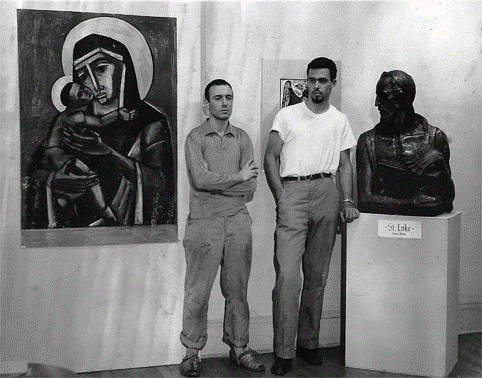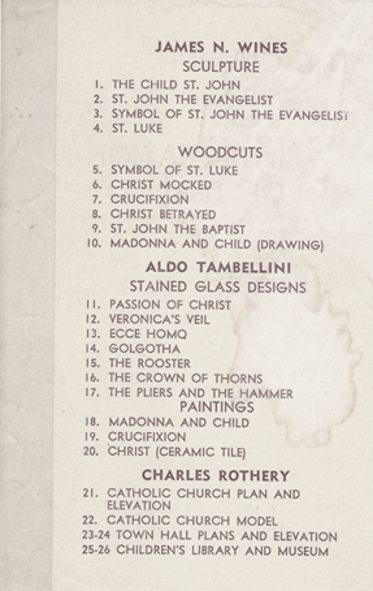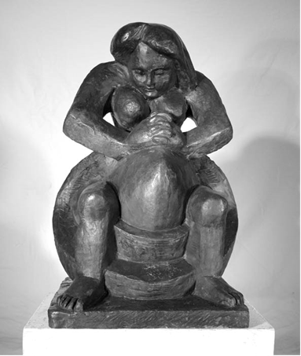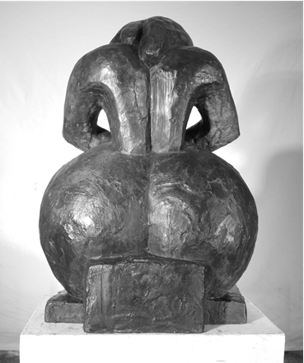1946 - 1959
Return to America
1946
Tambellini and his mother boarded the Marine Carp, destined for New York City. During the 15-day-journey, Tambellini met a young poet from Rome, Gianni Cappelli, who was associated with the modern Italian poet, Giuseppe Ungaretti. Talking to Cappelli exposed Tambellini to modern poetry and enlightened him to the importance of using simple, modern, expressive language that made poetry accessible to all people. Tambellini’s introductory experience writing poetry, first in Italian, and then in English, began not too long after.
morte
eravamo vicini
alla finestra
e si guardava il sole
verso il meriggio
poi ad un tratto
dal cielo
venne la morte
e nel terrazzo
un cavallo rosso di legno
rimase dondolando
ricordi di bimbi
death
around noon
we were
by the window
looking at the sun
when death
suddenly
came from the sky
& in the terrace
a red wooden horse
kept rocking
remembrance of children
from the first 16 poems, 1946, Tambellini
The first morning after landing in New York Harbor, Tambellini’s father told Tambellini’s mother that he would not be living with them. For some time, Tambellini lived alone with his mother in Syracuse, NY, who increasingly was becoming more paranoid, afraid of being spied on and surveilled.
…it was the 4th of july 1946
the next morning
next to my mother
from above the anchored “Liberty Ship”
I saw my father waiting by the pier below
is that my father I said
I feel I was so old & he so young
had time aged
my 16 years so much
in the train ride to Syracuse NY
my native city
my father speaks to my mother
of separation
the train window is
rapidly flashing the new landscape
dislocated frames
superimposed over fragments
from my wounded land across the ocean
fading to black
then winter came with its tragic events
snow / snow / more snow & ice / storms
more ice & snow
how does one communicate with winter darkness?
as the mother who gave me life in this city
fearfully re-entered the dangerously lived life
of world war II paranoia…
Excerpt from poem, January 6, 2005, Aldo Tambellini
1947
Tambellini’s mother, continuing to suffer from mental illness, was hospitalized in Rochester, NY and given shock treatments. She eventually returned to Italy to live with her mother, a devasting experience for Tambellini. Now on his own, Tambellini struggled to support himself, working at small jobs, such as picking potatoes with migrant workers.
mother
it is the night
they come
with the white van
three strangers
dressed in white
&
I as a decoy
have tricked you
into descending the stairs
in the january snow
falling
with the whitest of white
the white van
with the backdoor opened
parked by
that ancient poplar tree
on james street
in syracuse ny
the three men in white
acting
as a matter of fact
used to a routine
that must be performed
best in a swift way
you mother
suddenly aware of
what is about to happen
hold on to my arm
pleading
don’t
let them take me away
Excerpt from poem, October 19, 1990, Aldo Tambellini
This same year, Tambellini compiled a portfolio of his work and presented it to the curators at the old Syracuse Museum of Fine Arts. One of the art teachers there, Lee Brown Coye, introduced Tambellini to the Museum Director, Anna Holmstead. Holmstead, impressed with Tambellini’s work, offered him a position to teach painting. At 17, he was the youngest member of the museum staff, much younger than his students.
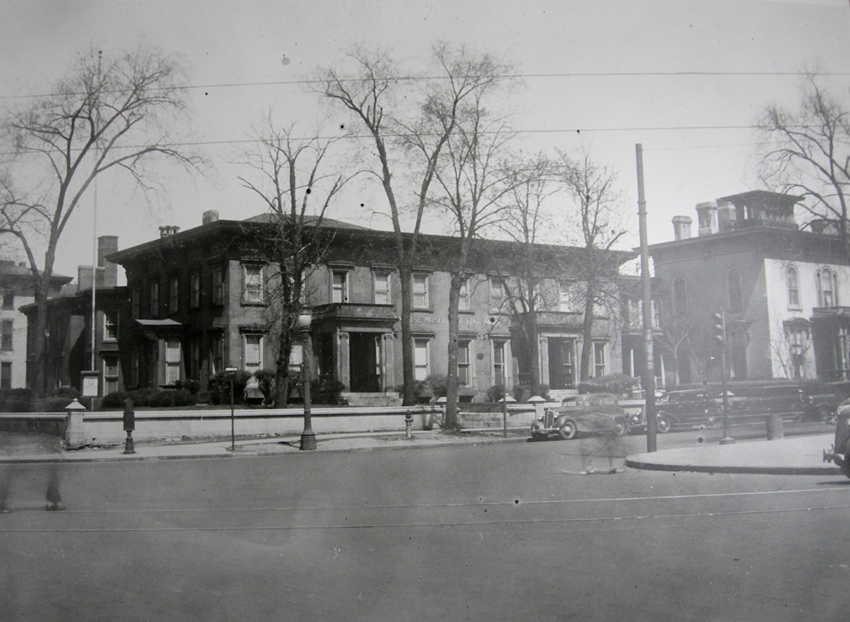
Syracuse Museum of Fine Arts on James Street, ca. 1930s,
Everson Museum Art Archive
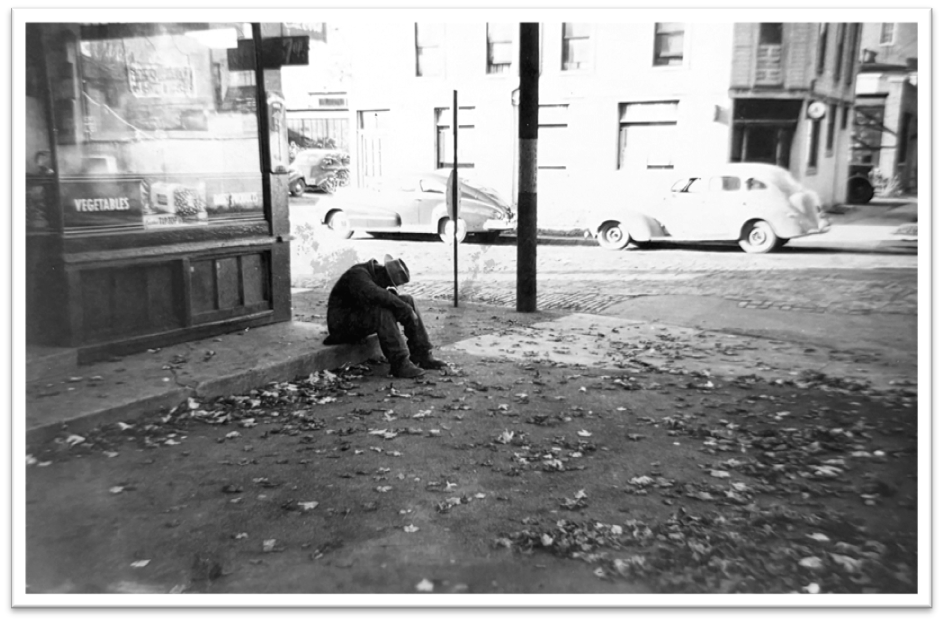
1948
Tambellini received a Kodak Brownie square camera as a gift and began capturing images of the widespread poverty in the 15th Ward. The population of this Syracuse neighborhood, home to Tambellini and other recent immigrants, was 90% African American. Additionaly, the 15th Ward was a casualty of the I-81 urban renewal project. This was Tambellini’s first photo essay, an opportunity to present his narrative of the disenfranchised. In the 2000’s, his photographs were displayed at the Inc Gallery, Syracuse University.
1949
Tambellini was asked by a group of much older artists to join their collective called VEDET. They shared a loft on Salina Street in Syracuse, NY. Some of the members were from New York City, among them Hilton Cramer and James Kleege. This was Tambellini’s first exposure to Avant-Garde art. Tambellini would go to the loft and create art well into the night, indulging in the group’s many records of classical and jazz music. It was here, for the first time, that Tambellini heard the haunting sound of Billie Holiday.
Some of the artists of VEDET, in particular James Kleege, encouraged Tambellini to submit his artwork to the scholarship competition at Syracuse University. A central part of his portfolio was his painting, The Funeral, in which the 18-year-old artist painted his self portrait as an old man. After applying, Tambellini became one of two winners of a four year, full tuition scholarship to Syracuse University. Tambellini’s mentors at VEDET told him, after his acceptance, that The Funeral was most likely the work that secured his spot at the university.
Unfortunately, this very important painting was lost. Tambellini had asked a friend to store the painting while he attended Syracuse University. During that time, the friend’s roof collapsed and “The Funeral,“ along with many of Tambellini’s other works, was destroyed.
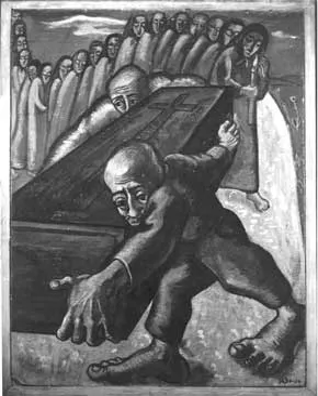
The Funeral, 1948
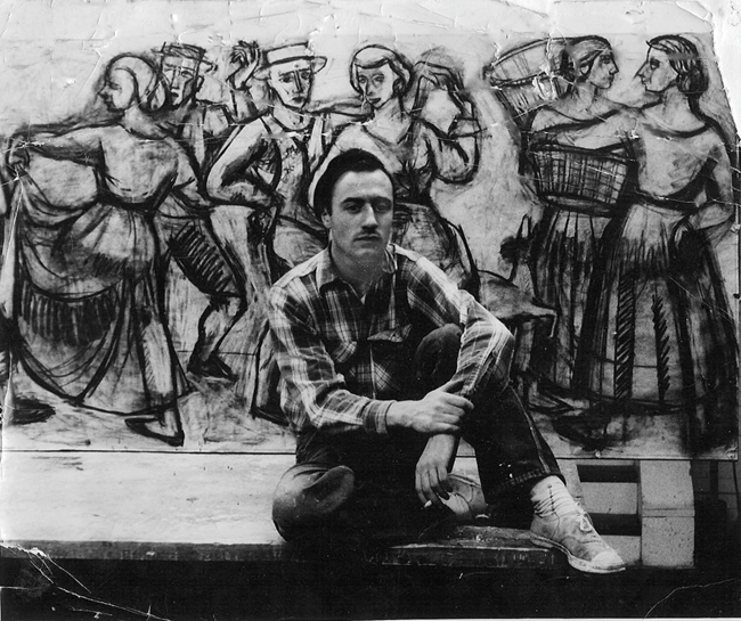
Tambellini in front of portion of restaurant mural, ca. 1950
1950
Tambellini enrolled as a freshman at Syracuse University.
While a student, Tambellini was commissioned by a local restaurant owner in Syracuse to paint a mural and other works for his new Italian restaurant. Having a premonition that the “young man” would return for his work, the restaurant owner’s wife saved the artwork in storage after the restaurant closed. Over fifty years later, while still searching for the work at the age of 74, Tambellini was reunited with these pieces.
1951
In the early 50’s, Tambellini’s friend, Harold Kasnitz, a physicist, was working at Syracuse University researching cosmic rays. It was in Kasnitz’s laboratory where Tambellini saw the metal chamber that detected the cosmic rays for the first time. He was shown several different photographs and what impressed him was that the rays, moving at a high speed, were invisible coming from outer space. They then only became visible when they hit the chamber surface, triggering a photograph. The photograph captured intricate patterns of lines created by a shower of released particles. Many years later, Kasnitz commented to Tambellini,
“Those photographs of cosmic rays, which you saw in Syracuse in the 50’s have obviously had a strong influence in your thinking and artwork. That was the beginning of a change in your artistic direction.”
Upon contemplation, Tambellini realized that his artistic method consisted of harnessing forces that were undetectable to the naked eye, the technology he used possessing the power to unveil the unseen. This concept of revealing the invisible through his artistic approach would serve as a driving factor in his creative journey.
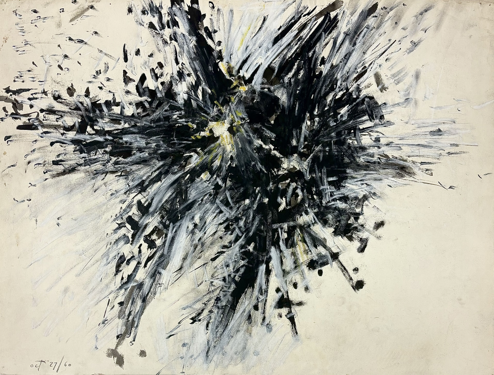

The boathouse at Camp Pinebrook
1952
Tambellini won the sophomore painting prize and a scholarship to Pinebrook, Syracuse University’s summer art school at Upper Saranac Lake in Upstate NY. It was here where he made his first attempt to paint on a large Masonite board. On the Masonite, Tambellini painted what he subconsciously believed to be a cosmic view, circular forms inside voids with other circular forms inside other voids.
“I could never capture what my mind was trying to envision. The interest was there, but I failed at representing it that summer. The painting is lost and it has become a memory.”
-Aldo Tambellini
1953
During his summer break in July 1953, Tambellini, who was in Syracuse, NY at the time, received news that the Mills Bros. Circus would be arriving in town. Intrigued by this, Tambellini made the decision to attend the circus and found himself captivated by the mesmerizing sights he witnessed, particularly the intricate social order that existed within the circus community. This experience served as a catalyst for Tambellini, inspiring him to become a part of the circus and embark on a journey of studying and documenting the lives of its members. For several weeks, Tambellini traveled with the circus, fully immersing himself in their daily routines and activities. He utilized various forms of artistic expression, including photography, drawing, painting, and poetry, all of which revolved around the performers and crew. This profound encounter with the circus community left an indelible mark on Tambellini, as he frequently referenced this experience in his later writings.
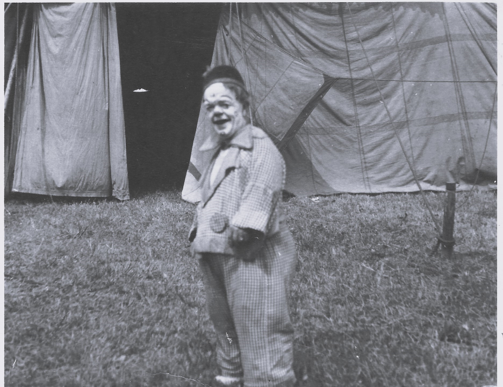
Photo by Aldo Tambellini, ca. 1953
1954
Tambellini, along with his best friend, James Wines and two other seniors from the School of Art at Syracuse University had a group show at the Syracuse Museum of Fine Arts, “Risveglio.” This was Tambellini’s first museum show.
Tambellini received a BFA in painting from Syracuse University in 1954.

1955 - 1956
After receiving his BFA in painting, Tambellini took a teaching position at the Rosary Hill College in Buffalo, New York. Apart from teaching, Tambellini conducted art workshops and museum tours for the nuns at Rosary Hill College. During the summer of 1955, Tambellini became the Director of Art Seminar at Catholic University of America in Washington, D.C. In the summer of 1956, Tambellinni became a Painting and Design Instructor at Catholic University.
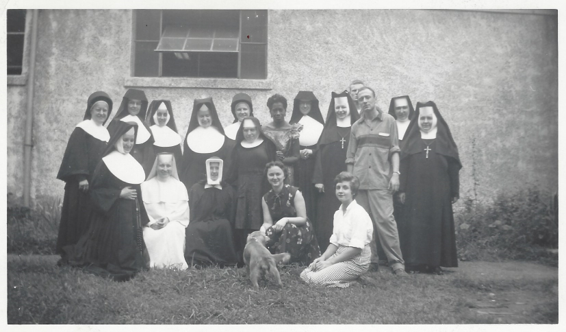
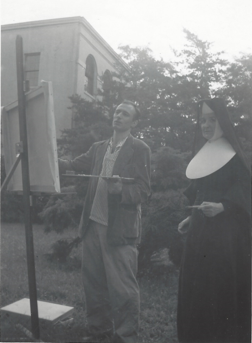
Tambellini was awarded a teaching fellowship at the University of Oregon in 1956.
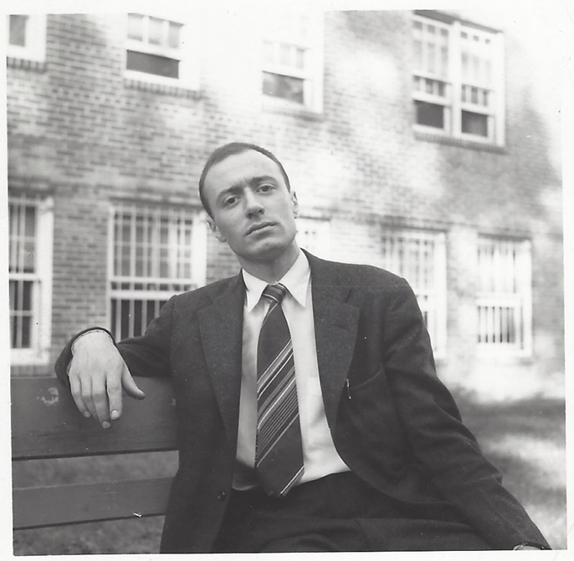
June 1955
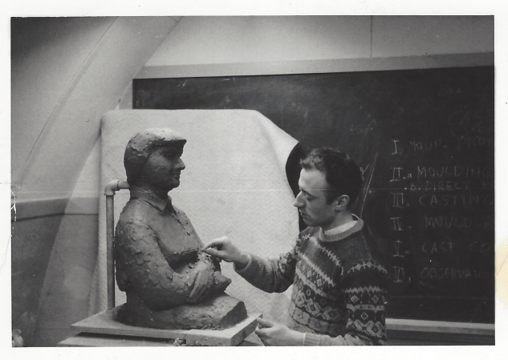
March 1956
1957 - 1959
Tambellini was invited by master sculptor Ivan Mastrovic to apply for a teaching fellowship, which he received, at the University of Notre Dame in South Bend, Indiana. During the period he studied with Mastrovic, Tambellini moved away from the iconic religious monuments that Mastrovic was creating, many of which were commissioned by the Vatican.
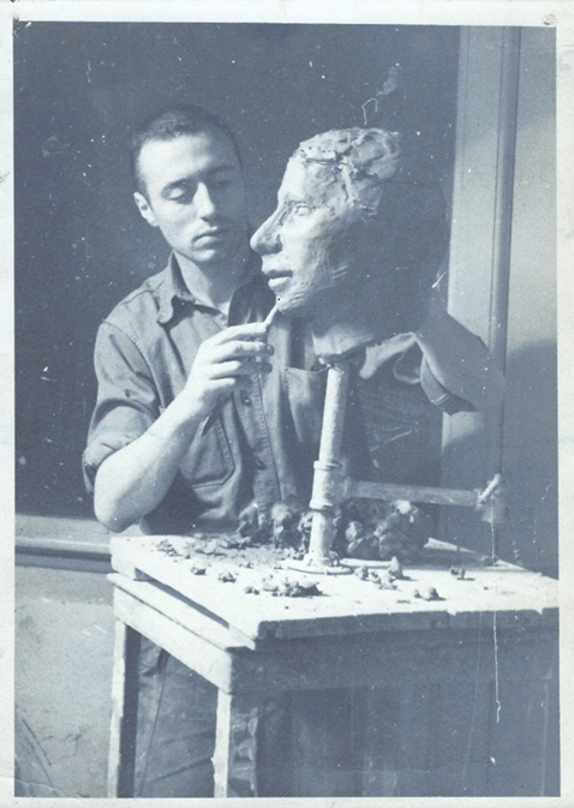
Instead, Tambellini’s sculptures became increasingly abstract and he began to develop his interest in the circular from. This culminated in his first piece emphasizing the circle, “The Pregnant Woman.” This foreshadowed the theme of artistic and biological creation that Tambellini would later return to in works such as his 1961 poem “The Seed.”
Tambellini graduated Notre Dame with an MFA in Sculpture in 1959.
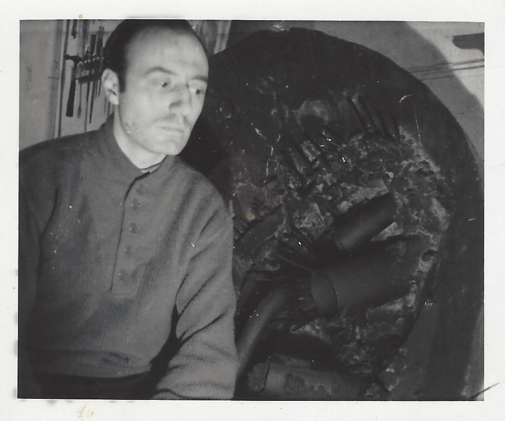
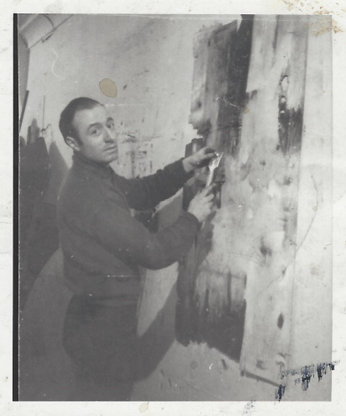
NEXT CHRONOLOGY CHAPTER

1959-1976
New York Years
“It was always my plan to go to New York City.”
-Aldo Tambellini


